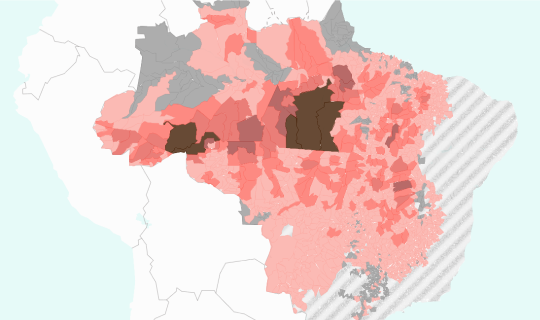Environmental, social and governance investing (ESG) has been in the dog house in recent months due to slumping values, PR disasters and fraud raids. ESG funds are supposed to finance companies with better sustainability performance, but these scandals are just the latest to highlight long-running concerns over ‘greenwashing’.
Nevertheless, the storm could act as a driver for ESG product providers to get their act together, especially on nature-related risks and deforestation in particular, which are only now starting to receive the attention they deserve from investors. ESG products need to be much more transparent in articulating which nature risks are incorporated into their environmental criteria and which are not, how those risks have been assessed and what due diligence process their fund holding has followed.
Trase Finance is a tool that can help with that task. By calculating traders’ municipality-level deforestation exposure for different countries and commodities, aggregating up to their ultimate publicly listed parent entities and then allocating that risk to shareholders according to the size of their holdings, Trase Finance can give detailed deforestation exposure estimates for each ESG fund and its asset manager. In doing so, it is quickly apparent that not all ESG is as forest-friendly as some ethical investors might expect.
Links between ESG and deforestation revealed
Our analysis of products that explicitly label themselves as ‘ESG’ highlights 406 funds, run by 95 financial institutions, that have direct commodity deforestation exposure through their holdings. Between them, they hold 1,390 separate shareholdings in ‘forest risk’ issuers with a market value of nearly $4bn. These forest-risk traders between them have a total deforestation exposure of almost 280,000 hectares per year.
Unsurprisingly, the well-known behemoths that dominate the exchange-traded fund and mutual fund arena top the ESG deforestation exposure league table.
Blackrock leads with its 262 ‘positions’ or holdings in 57 funds comprising a range of commodity deforestation exposures, particularly Brazilian soy via Bunge and Archer-Daniel Midlands. That risk is particularly prominent in its MSCI USA labelled funds. It also has beef deforestation exposure, especially through its iShares emerging markets-screened products, where impacts from Minerva in Paraguay feature strongly.
Meatpackers JBS, Minerva and Marfrig are also key drivers behind State Street’s second-ranked ESG deforestation exposure.
Third comes Northern Trust. The exposure of its worst performing ESG fund is driven by a combination of JBS and Indonesian palm oil deforestation exposure from Kuala Lumpur Kepong and Sime Darby.
ESG funds vary in terms of the breadth of their exposures as well as the scale, from the highly concentrated one-stock hits (for example, ‘Nuveen mid-cap value’ via Bunge) to the widespread risk of the ‘Vanguard ESG International’ exchange-traded fund on the other. The latter packs 32 deforestation exposure stocks into an ESG-branded fund including deforestation-linked traders Minerva (ranked first for exposure to Paraguayan beef), Golden Agri and Wilmar (first and third respectively for exposure to Indonesian palm oil) and Marfrig (third for Brazilian beef).
For some ESG funds, it is hard to say if they are demonstrating any real screening for nature risks at all. Applying the most limited ‘peer ranking’ criteria possible (screening only the single worst performing trader name for each context) still finds 125 ESG funds failing the test.
Quick wins aplenty
That concentration of risk can also be a benefit. ESG funds can easily transform their risk profile by filtering a small number of issuers out of their selection universe. Excluding the top 10 risk names might only cut out a quarter of the number of positions due to a ‘long tail’ of smaller risk names, but it would wipe out around 97% of the funds’ collective deforestation exposure in terms of impact.
Of course, there is an ongoing debate among investors over the merits of exclusion-based ESG versus active engagement. But that should not be used as an excuse for failing to address the need for ESG funds to become far more explicit in setting robust criteria, governance processes, engagement requirements and escalation frameworks.
Trase Finance can also assess indirect deforestation exposure which comes from further out in the ownership network. Here, ESG funds have an additional 10,000 or so positions. That ‘inherited’ deforestation exposure may be limited (less than 10% than that coming from their direct trader holdings), but ESG providers still have a responsibility to assess, manage and respond to these indirect risks as part of a proper due diligence process.
ESG may be under fire, but those financial institutions that are serious about tackling the drivers of deforestation can emerge stronger for it. Trase Finance can be used to improve transparency and ensure that there are quantifiable measures to hold funds to account for their exposures. It can provide the tools for financial institutions to conduct proper due diligence and portfolio screening of all products, especially those that are sold on the strength of their environmental goals.
To reference this article, please use the following citation: Levett, B. (2022). How forest-friendly are ESG funds? Trase. https://doi.org/10.48650/DZ37-1M42
Was this article useful?


